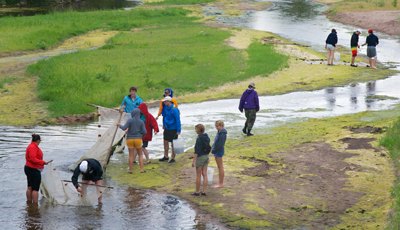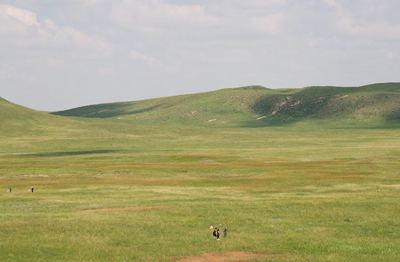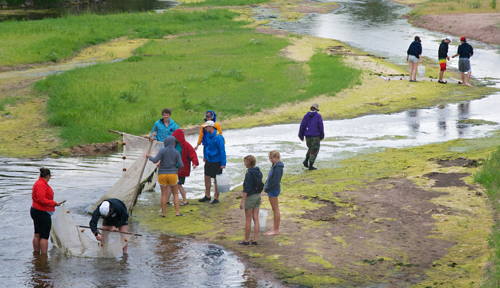 |
Students get their feet wet in the study of field epidemiolgy. |
They’ve collected grasshoppers and studied them for mites.
Treated toads for intestinal protozoans.
Exposed small, freshwater crustaceans to predation from beetle larvae.
And gotten great tans.
As the annual Field Epidemiology course wrapped up its sixth summer last week, instructor Devin Nickol, M.D., called it “another very successful year.
“The students continue to surprise me with their enthusiasm and creativity,” Dr. Nickol said.
See more photos from the class here.
Besides great weather — temps in the first week were in the 80s and 90s at Cedar Point Biological Station near Ogallala — the class has included field exercises designed to illustrate principles of epidemiology and evidence-based medicine, including prevalence (the grasshopper/mite study), mortality rates (the unfortunate crustaceans) and randomized trials (the toad intestinal treatments).
The course was created in 2008 by Dr. Nickol, in part to introduce real-world aspects of evidence-based medicine that are difficult to reproduce in the classroom. Sometimes called “shoe leather epidemiology,” field epidemiology involves direct observation and investigation of interactions between a disease and the affected population.
Students dig through mud, search tall grasses and wade in streams as they learn to apply evidence-based methodology under real-world conditions.
 |
Students on the Arapahoe Prairie |
Dr. Nickol said this may be the only introductory-level epidemiology class in the world that includes real-world field exercises and experiments to reinforce the material.
“Students read about concepts like randomized trials, and then they have the chance to do one,” he said. “They learn the theory of topics like biostatistics, and then use them to answer actual experimental questions. These are the skills they will use during the rest of their scientific careers.”
This year’s enrollment of 17, mostly undergraduates from UNO and UNL, is the most ever — evidence of the steadily increasing popularity the program has enjoyed, in part due to word-of-mouth among students.
“Class size is limited by the amount of cabins and space in class vehicles, but I don’t think I’d want the class to get much bigger than its current size anyway,” Dr. Nickol said. “This seems about optimal for the sort of interactive learning that the class emphasizes.”
The class is rewarding for Dr. Nickol, as well.
“Not a class day goes by when I don’t learn something new about the biology of the Sandhills,” he said. “An even more rewarding part of each day is watching students make the leap from the theory they read in a book the night before to a real-world application they’ll remember forever.”

Hi Dr. Nickol! What a fantastic program! Thanks for all you do to promote public health and the University!
My son was in this class and spoke highly of his experience there!